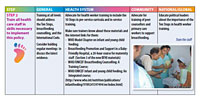|
|
|
Step 2: Train all health care staff in skills necessary to implement this policy.
Every facility providing maternity services and care for newborn infants should:
Step 2: Train all health care staff in skills necessary to implement this policy.
All health care staff who have any contact with mothers, infants and/or children must receive instruction on the implementation of the breastfeeding policy. Training in breastfeeding and lactation management should be given to various types of staff including new employees, it should be at least 18 hours in total with a minimum of 3 hours of supervised clinical experience and cover at least 8 steps.
Training at all levels should address the 10 steps, breastfeeding, counselling, and the International Code.
A policy is of no use unless it is implemented. So the second step is to train all doctors and nurses in skills necessary to implement this policy. It ensures that the majority of the staff members are trained in breastfeeding counselling.
|
What You Can Do.
 Step 2: WABA Action Chart Step 2: WABA Action Chart
What You or Your Organisation Can Do >> click here
World Breastfeeding Week Action Folders  >> English - Spanish >> English - Spanish
- General
Training at all levels should address the Ten Steps, breastfeeding counselling, and the International Code.
Consider holding regular meetings to discuss the latest evidence.
- Health System
Advocate for health worker training to include the 10 Steps in pre-service curricula and in-service training.
Make sure trainers know about these materials and the internet links for them:
- Community
Advocate for training of peer counsellors and primary care workers to support breastfeeding.
- National / Global
Educate political leaders about the importance of the Ten Steps in health worker training.
|
Key Points:Training should include:
- Advantages of breastfeeding
- Risks of artificial feeding
- Mechanisms of lactation and sucking
- How to help mothers initiate and sustain breastfeeding
- How to assess a breastfeeding session
- How to resolve breastfeeding difficulties
- Orientation and education on hospital breastfeeding policies and practices
- Importance of feeding on cue
- Positioning and attachment
- Risks of artificial feeding and using bottles
HIV Issues to Consider Step 2: Train all health care staff in skills necessary to implement this policy. Step 2: Train all health care staff in skills necessary to implement this policy.
Issues to consider while implementing this step in relation to feeding recommendations for children of HIV-infected mothers and for settings with high HIV prevalence.
- Staff training needs may vary from facility to facility.
- If the hospital is already a baby-friendly hospital, then emphasis should be placed on refresher training related to HIV and infant feeding.
- If the facility has never implemented the BFHI then BFHI training will need to include guidance related to HIV and infant feeding, or additional training on this topic will need to be organized, requiring more time and training resources.
- Training may require a multi-sectoral training team from nutrition, HIV/AIDS and other MCH sections.
- If there are no master trainers available locally with experience in implementing BFHI in settings where HIV-positive mothers receive care, external trainers may be needed.
15 August, 2013
|
